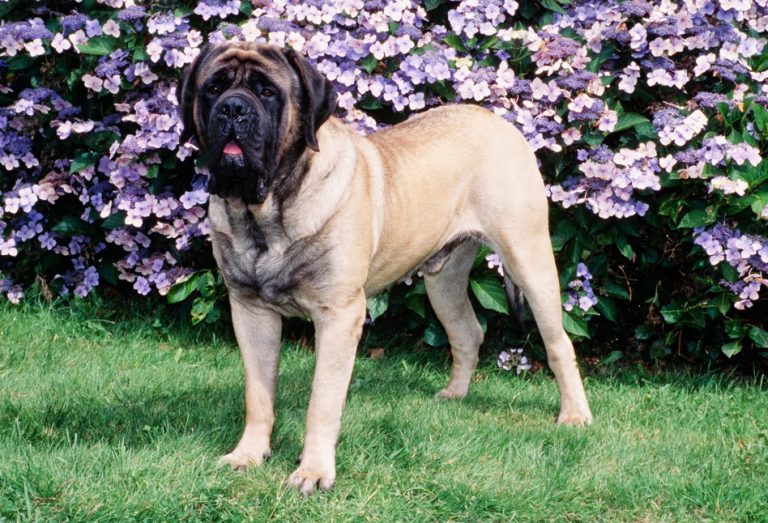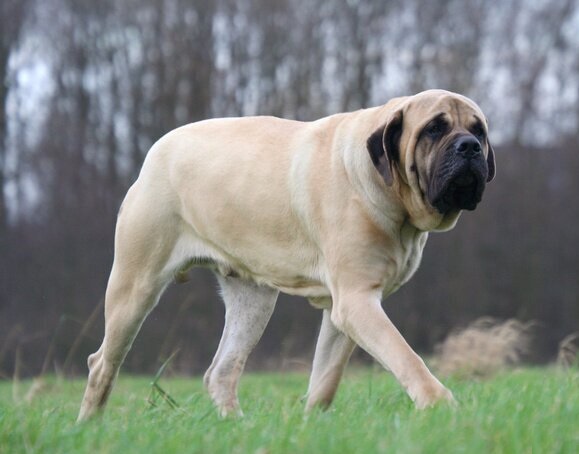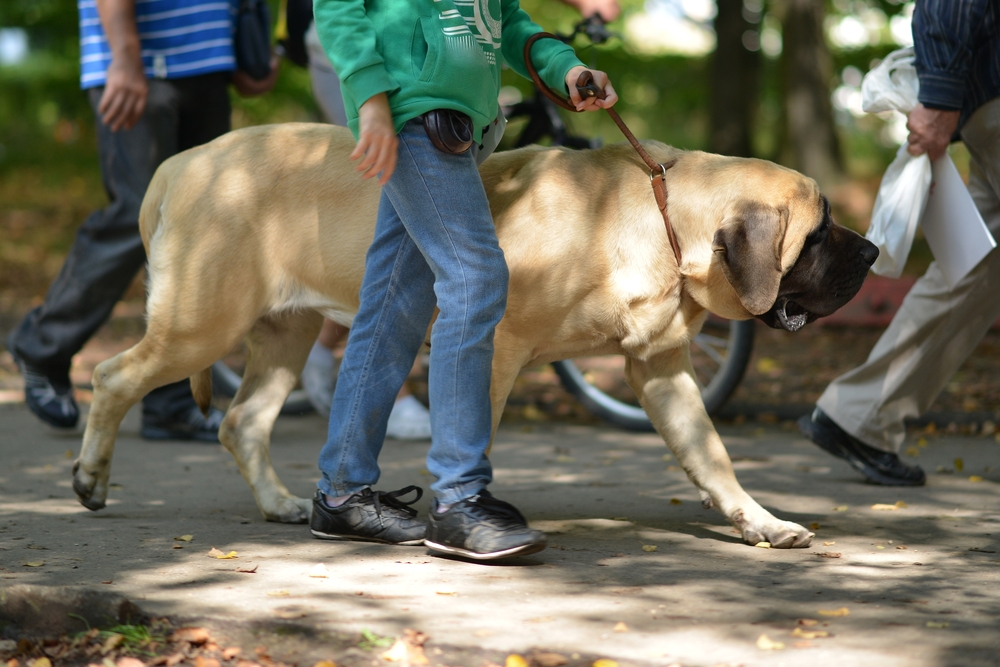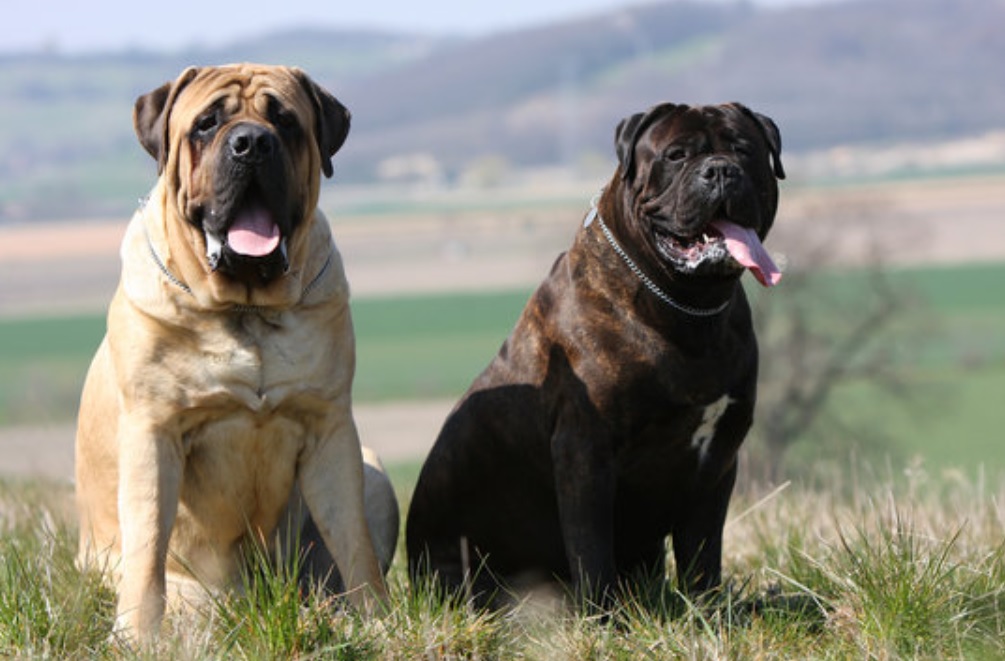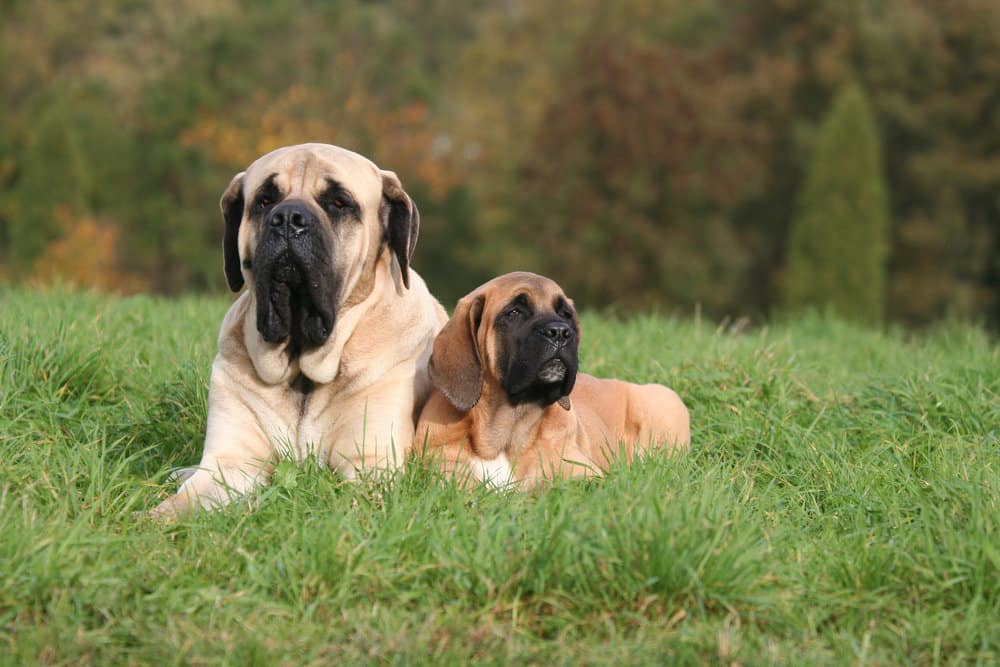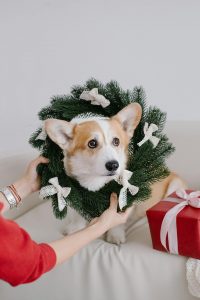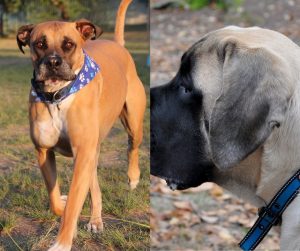Fully grown, a male English Mastiff will stand 30 inches tall and can weigh as much as 200 pounds. Now isn’t that something big? A female English Mastiff grows up to 27 inches and weighs around 150 pounds.
Truth be told, an English Mastiff is a massive, powerful, and muscular dog. They have heavy heads with short muzzles, making them look even more big and powerful. Today, we will take a look at some of the fun English Mastiff facts, but also at the dog’s behavior, history, appearance, training, and health traits.
Let’s take a look.
Breed ID
Origin: England
Size: 27 to 30 inches
Weight: 130 to 200 pounds
Lifespan: 6 to 12 years
Group: Working Dog Group
Breed Overview
The English Mastiff, or simply called the Mastiff, is a British dog breed of very large size. According to most historians, it descended from the ancient Alaunt and Pugnaces Britanniae, with some genetics from the Alpine Mastiff in the 19th century.
You can easily distinguish it by its massive size, large head, short coat, and limited range of colors. They also always display a black mask. Despite their large size, these dogs are noted for their gentle and loving nature.
The modern lineage of Mastiffs can be traced back to the 19th century, but many believe that the lineage was stabilized in the 1880s and refined since.
Throughout its history, the adult Mastiff also contributed to the development of many other breeds. While they are also called mastiffs, only the English one is a true Mastiff.
Here is another interesting fact. It is the largest living canine, outweighing the wolf by up to 100 lbs on average.
History
Now let’s talk about some history lessons. Also known as Old English Mastiff, the dog is of ancient heritage. According to historians, these dogs were found in Britain when the Romans invaded the island. The Romans came there guided by Phoenician traders in the 6th century BC. The Romans employed the dogs as guardians for sheep and bodyguards for people.
Dogs of this type were found in European and Asian records dating back to 3000 BCE. Sometimes, the dog is called the Molossian breed. Some of these mastiff dogs functioned as war dogs, for example, the Cane Corso.
When the Romans invaded England, they sent the English mastiff to compete in the arenas of Ancient Rome, fighting against bears, lions, tigers, bulls, and other dogs. Even human gladiators. They considered the adult dog as a war dog. And used it as such.
In the 19th century, breeders came up with the Bullmastiff, a cross between the Mastiff and the Bulldog.
As for Mastiffs in the United States, according to experts, it came on the Mayflower. Nowadays, the dog is established in England, Canada, and the US. Recognized by The American Kennel Club, the dog’s talents include guarding, police work, military work, search and rescue, and more. Yet, many mastiffs nowadays are on a mission to provide companionship to their human owner.
Appearance
We touched a bit on the appearance of the large breed. With their massive body, broad skull, and head of generally square appearance, they are the largest dog breed in terms of mass. The Great Dane is the tallest dog, but the English Mastiff is the biggest dog.
While breeds like the Irish Wolfhound and Great Dane can grow up to six inches taller, they are not nearly as robust.
So, let’s talk about the appearance of the English Mastiff. They have a large body with great depth and breadth, especially between the forelegs. Their forelegs are set wide apart. The AKC breed standard says they need to grow between 27 and 30 inches at the shoulder. They typically weigh between 150 and 250 pounds. Yet, some individuals reach even 300 pounds.
When we talk about coat color standards, it says their coat should be short and close-lying. Yes, there is a thing like the long-haired mastiff, often called Fluffies. But that is caused by a recessive gene, and it is rarely seen. The American Kennel Club considers the long coat a fault, but not a cause for disqualification.
Accepted coat color options include apricot fawn, silver fawn, fawn, or dark fawn brindle. There should always be black on the muzzle, ears, nose, and around the eyes.
The Guinness World Record Holder
As we mentioned previously, some large breed mastiffs can grow as much as 300 lbs. The Guinness Book Record Holder was an English Mastiff named Aicama Zorba of La Susa. That dog weighed 343 pounds.
That happened in March 1989, when Zorba was 7 years old, and stood 37 inches at the shoulder from the tip of the nose to the tip of his tail. He was the size of a small donkey. Since 2000, The Guinness Book of World Records does not accept the largest or heaviest pet records.
Temperament
We can now continue to another section of English Mastiff facts, and that is temperament. These dogs have a big personality that will match their large body. Affectionate and eager to please, they might even try to be a lap dog.
A lot of people mistake the English Mastiff for an aggressive dog. But the reality is that a well-socialized Mastiff treats strangers as normal people. They are quite affectionate and friendly, and loving family dogs. Now, they are not the gentle giant as the Great Dane. Of course, their guarding instincts persist, but that is where socialization helps.
After all, you have to remember, this breed was bred to be a guard dog. They do love their family to the bone. In the home, when growing up with other animals, they can function and be compatible. Even with cats.
Now, once they reach adulthood, their play periods are generally short in duration. The sheer size and strength can make it difficult for children or elderly people to manage. But they are loving and eager to please dogs. Their low energy and sheer bulk make them a poor choice for families that want an active dog.
The Mastiff should be a combination of grandeur and good nature, courage, and docility. They are always dignified, but never shy or vicious.
Like every other dog, they benefit from proper socialization and being exposed to different people, environments, sounds, experiences, and animals.
Training
Here is the good news. Training a Mastiff should be a fairly easy task. These dogs are eager to please and love to work. After all, they are part of the working dog group by AKC standards.
The challenge, of course, is the big size. The Mastiff’s sheer size and weight can make it difficult for some owners to handle their dogs.
But we have to note, obedience training is a must for this giant breed. They are sweet and loving. Yet, a full-size Mastiff without good manners can be dangerous and unmanageable.
Exercise Needs
As we mentioned previously, these dogs are not the most active ones. Their sheer bulk makes it impossible for the Mastiff to walk for more than 30 minutes. The weight of their body will weigh them down.
That being said, two short walks per day is more than enough. The English Mastiff is more than happy to lie around and observe.
Do not be surprised if this dog wants to sit in your lap and sleep. They are cuddlers!
Health
Throughout his life, the Mastiff should show massiveness and sound movement. The downside of owning such a giant breed is that they are prone to more health risks. Dogs like Mastiff, Dogue de Bordeaux, Saint Bernard, Cane Corso, Great Dane, Presa Canario, and similar do not live a long life. Yes, breeders have tried mixing them with other dogs for longer lifespan.
And that generally works. Yet problems like hip dysplasia, gastric torsion, obesity, hypothyroidism, cardiomyopathy, allergies, and more persist. These dogs are prone to many diseases.
That is why the average lifespan of a Mastiff dog breed is about 7 years. It is not uncommon for them to live between 10 and 12 years. The record is held by a female named Kush that lived up to 15 years. But that is a rarity.
Grooming
Here is a fun fact. Mastiffs are house dogs that can adapt to any environment, city, or country. Yet, they do best in a home with a fenced yard.
Speaking of their grooming needs, their short coat needs brushing only once per week. They do not shed as much and do not have blowout seasons.
But the bigger challenge in terms of grooming is cleaning their wrinkles. You have to do it daily to prevent bacterial infection. Wipe the wrinkles out with a damp cloth and then dry thoroughly. Do the same for the flews, which are the hanging part of the upper lip after every meal.
Different Types Of Mastiff Dogs
We mentioned that the English Mastiff is the true mastiff. But we also said other breeds have been created thanks to the genetics of the English mastiff. Let’s mention them briefly.
- The Neapolitan Mastiff is an Italian breed who has large, loose skin and heavy wrinkles on the face and body. They have a muscular build, but grow slightly lower, between 110 and 150 pounds
- Bullmastiff is another dog developed in Great Britain to guard estates and catch poachers. They are a mix between an English Mastiff and Bulldog
- Tibetan Mastiff originates from Tibet. It is another ancient breed famous for its impressive appearance and protective nature. Their thick double coat is quite different than other mastiffs. But it is there to protect them from the harsh weather conditions. There is not much lineage relation between the Tibetan Mastiff and the English Mastiff
- Dogue de Bordeaux, or Bordeaux Mastiff, or French Mastiff, it is the French version of the Mastiff. They weigh between 110 and 140 pounds
- Brazilian Mastiff, or Fila Brasileiro, is a Brazilian breed known for tracking and guarding abilities. Compared to English Mastiffs, they have a much higher and stronger prey drive
Fun Facts
Now let’s take a look at some fun and interesting facts about the English Mastiff.
- Descended from Ancient Roman War Dogs, another example of how Ancient Romans left their mark on the world
- Sailed on the Mayflower. John Goodman, the 25-year-old pilgrim, brought his English Mastiff on the Mayflower with him, and they sailed to the New World
- At one point they were fighting dogs, bred and trained for dog fighting, bull baiting, and one-on-one arena fights in Ancient Rome
- Most canine experts agree that the Mastiff we have today was created by the British, who used their dogs to guard estates and castles
- When Hannibal crossed the Alps, he had several battalions of war-trained Mastiffs to accompany him
- During World War II, people in Britain were encouraged to euthanize their pets to preserve food stocks. Making the choice between feeding their dogs and the populace, the choice was easy. As a result, the population shrank to nearly nothing, but it came back from extinction
- The dog is the biggest dog breed in terms of mass
- Mastiffs have the biggest litter, with a typical female English Mastiff giving birth to 10 to 12 puppies. The biggest litter on record was 24 puppies, with 20 of them surviving past the first week
- They have been on the Silver Screen, for example, Hagrid’s dog in the Harry Potter franchise
- The US never had a real importation of Mastiffs until the late 1800s
- In 1835, the Parliament of the United Kingdom enacted the Cruelty to Animals Act, outlawing various brutal sports such as bull baiting. It was another blow to the dog breed, but dog shows and their popularity revived the interest in Mastiffs in the late 19th century
- While they protect their territory, Mastiffs do not bark to intimidate. They will bite before they bark when you invade their property
- Their puppy stage lasts longer compared to other breeds. It will take them between 18 and 24 months before they reach full maturity
Mastiff Celebrity Dog Owners
Let’s finish off our article on English Mastiff facts with some celebrity dog owners.
- Marlon Brando, arguably the most popular Mastiff owner, was an American actor, film director, and activist
- Kirstie Alley was an American actress and comedian famous for her role in the television series Cheers
- Gayle King, the co-anchor of CBS This Morning and editor at The Oprah Magazine, is another celebrity Mastiff owner
- Former professional baseball player Larry Wolfe owned a Mastiff as well
- We have to mention Michael Bay, the famous American filmmaker as well
- Next on the list is Flea, or Michael Peter Balzary, the American musician and occasional actor
- Speaking of musicians who owned a Mastiff, Bob Dylan is also on the list
- Then, we also have Jon Bon Jovi, one of the most famous American singers
- Mastiffs do well with singers it looks, as Christina Aguilera also owned one
- We can finish off the list with two big American actors, Vin Diesel and Dwayne Johnson. The Mastiff certainly has the size to match their own

